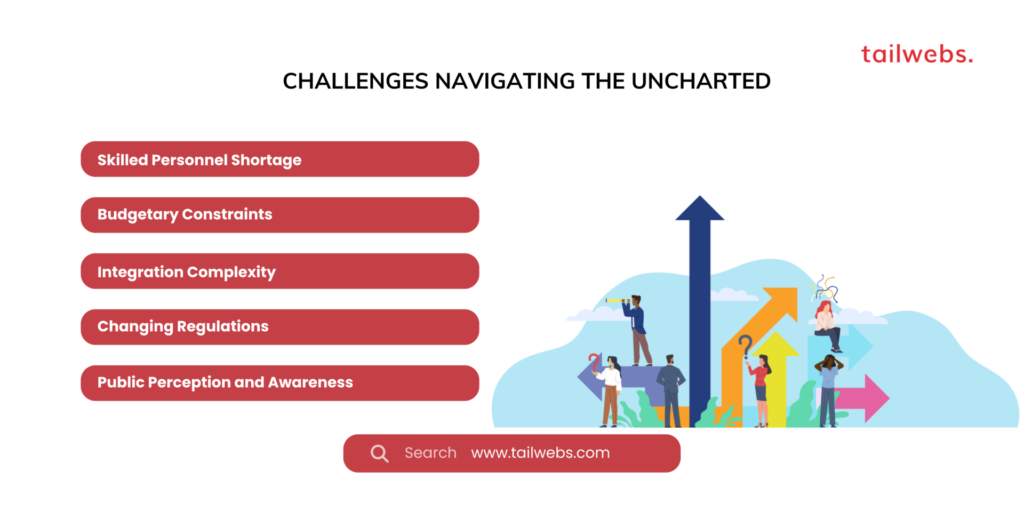Gazing into the Crystal Ball: The Future of Cybersecurity – Threats on the Horizon and Innovations to Combat Them
The digital landscape is constantly evolving, and with it, the threats to our data and online security. While traditional firewalls and antivirus software still hold merit, the future of cybersecurity demands a forward-thinking approach, anticipating emerging threats and developing innovative solutions to stay ahead of the curve. So, intrepid cybersecurity champions, don your futuristic visors and join us on a voyage into the uncharted waters of the cybersecurity future!
Emerging Threats Looming on the Horizon:
The Rise of Artificial Intelligence (AI): While AI can play a vital role in threat detection and response, it can also be weaponized by attackers, crafting more sophisticated malware and launching autonomous cyberattacks.
Quantum Computing’s Double-Edged Sword: While offering potential for advancements in cryptography, the power of quantum computers could compromise existing encryption methods, necessitating the development of post-quantum cryptography solutions.
The Expanding Internet of Things (IoT): As more devices connect to the internet, the attack surface expands, creating new vulnerabilities for attackers to exploit in interconnected networks.
Social Engineering’s Evolution: Deepfakes and personalized phishing scams, leveraging AI and social media data, could become even more convincing and difficult to detect.
Supply Chain Attacks: Targeting vulnerabilities in software development and third-party vendors could become more prevalent, impacting entire ecosystems.

Stats Painting a Worrisome Picture:
- The global cybersecurity market is expected to reach $418.18 billion by 2027. (Statista, 2023)
- The average cost of a data breach is $4.24 million. (IBM Security, 2023)
- 68% of organizations experienced a cyberattack in the past year. (Accenture, 2023 Cybersecurity Report)
- Only 38% of organizations consider themselves fully prepared for future cyberattacks. (EY Global Information Security Survey 2023)
From Sci-Fi Fiction to Reality: Innovative Solutions Shaping the Future
AI-Powered Security Systems:
Leveraging AI for threat detection, anomaly analysis, and automated incident response can enhance speed and efficiency in threat mitigation.
Zero Trust Architecture:
Moving beyond perimeter-based security, zero trust verifies every user and device before granting access, minimizing the impact of breaches.
Biometric Authentication:
Fingerprint, facial recognition, and other biometric methods offer more secure and convenient user authentication options.
Quantum-Resistant Cryptography:
Developing and implementing post-quantum cryptography algorithms will be crucial to safeguard data in the era of quantum computing.
Continuous Security Testing and DevSecOps:
Integrating security testing throughout the software development lifecycle and collaborating between development and security teams can proactively identify and address vulnerabilities.

Recommended Tools and Technologies:
XDR (Extended Detection and Response) Platforms:
Tools like Palo Alto Networks Cortex XDR and MacAfee Endpoint Security for Enterprise offer comprehensive threat detection and response capabilities across various security domains.
AI-Powered Security Analytics Platforms:
Solutions like Darktrace and Deepwatch utilize AI to analyze security data and identify sophisticated threats in real-time.
Zero Trust Network Access (ZTNA) Solutions:
Tools like Zscaler Private Access and Cloudflare Zero Trust provide secure remote access without the need for traditional VPNs.
Biometric Authentication Systems:
Fingerprint scanners, facial recognition cameras, and voice authentication solutions from companies like HID Global and Suprema offer secure and convenient access control.
DevSecOps Automation Tools:
Platforms like GitLab and Jenkins integrate security testing tools into the development pipeline, streamlining DevSecOps practices.
Challenges Navigating the Uncharted:
Skilled Personnel Shortage:
Finding and retaining qualified cybersecurity professionals with expertise in emerging technologies can be challenging.
Budgetary Constraints:
Implementing cutting-edge solutions requires investment, necessitating effective communication and justification of the value proposition.
Integration Complexity:
Integrating new technologies with existing security infrastructure can be complex and time-consuming.
Changing Regulations:
Adapting to evolving data privacy regulations and compliance requirements adds another layer of complexity.
Public Perception and Awareness:
Educating users about emerging threats and promoting responsible online behavior remains crucial.

Building a Collaborative Tomorrow: United Against the Future’s Threats
Conquering these challenges requires a collaborative effort:
IT Security Teams:
Stay updated on emerging threats, implement new technologies, and lead the technical aspects of cybersecurity strategy.
Management:
Champion cybersecurity as a strategic priority, allocate resources for training, tools, and personnel, and foster a culture of security awareness.
Legal and Compliance Teams:
Ensure compliance with data privacy regulations and advise on the legal implications of new technologies.
Software Developers:
Integrate security practices into the development lifecycle and collaborate with security teams to build secure software from the ground up.
Human Resources:
Conduct security awareness training, address employee concerns, and promote secure habits within the organization.
Industry Collaborations:
Share knowledge, best practices, and threat intelligence with industry peers to collectively enhance defences.
Government Agencies:
Implement policies and regulations that promote cybersecurity best practices and hold malicious actors accountable.
By working together and harnessing the power of collaboration, we can build a more secure digital future.
Here are some additional tips to ensure your collaborative efforts shine brightly in the face of ever-evolving threats:
Foster a Culture of Continuous Learning:
Encourage continuous learning and skill development for your cybersecurity team to stay ahead of the curve.
Promote Open Communication:
Create a culture where employees feel comfortable reporting suspicious activity and raising security concerns without fear of reprisal.
Measure and Improve:
Regularly assess the effectiveness of your cybersecurity strategy and make data-driven decisions for continuous improvement.
Stay Informed:
Subscribe to industry publications, attend security conferences, and participate in online communities to stay updated on emerging threats and solutions.
Embrace a Forward-thinking Mindset:
Don’t wait for threats to materialize; proactively explore emerging technologies and their potential security implications.
Remember, the future of cybersecurity is not a pre-written script; it’s a story we collectively write through our actions and choices. By embracing innovation, collaboration, and a spirit of continuous learning, we can build a digital world where data is safe, privacy is respected, and the threats of tomorrow are met with vigilance and resilience. So, join the quest for a secure future, equip yourselves with the tools of knowledge and collaboration, and together, let’s chart a course towards a brighter, more secure digital horizon.





